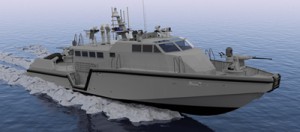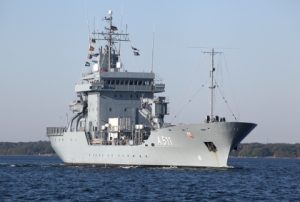 The prospect of high-end maritime warfare is no excuse to forget everything about low-end conflict and shrug off the valid, real-world lessons gleaned from gritty, grinding low-end sea conflicts like, oh, the Sri Lankan small-boat war. Sri Lanka demonstrated that small boats are critical in the low-end fight and suggested that they might be darned useful in a high-end maritime conflict.
The prospect of high-end maritime warfare is no excuse to forget everything about low-end conflict and shrug off the valid, real-world lessons gleaned from gritty, grinding low-end sea conflicts like, oh, the Sri Lankan small-boat war. Sri Lanka demonstrated that small boats are critical in the low-end fight and suggested that they might be darned useful in a high-end maritime conflict.
The long-festering civil war in Sri Lanka was a pretty interesting laboratory for maritime warfare, re-emphasizing some lessons from the “high PT Boat” era in the South Pacific. In Sri Lanka, small gunboats armed with rapid-firing 20mm and 30mm auto-cannons, supplemented by a changing cast of smaller weapons (grenade launchers, machine guns, etc.), were used to seal off large sections of coastline, sanitize areas, and to secure sea room for larger ships. But Sri Lanka was an off-the radar sideshow, quickly forgotten by those in “big war” maritime strategy set.
It’s happened before.
In an earlier war, PT Boats captured the romantics, getting headlines for their occasional audacity in rarely attacking capital ships (and by being largely ineffective when they did). But their real jobs were to do everything else the more glamorous big ships didn’t do. PT Boat escort missions for smaller craft were as critical as they were unheralded. PT Boats played a huge role in the interdiction and destruction of low-level, unit supply lines–but the dangerous and dirty business of attacking and sinking resupply barges didn’t often make headlines. PT Boats didn’t win big sea battles, but they ensured that gains made by bigger ships were consolidated and maintained–critical battlefield missions that are discounted today.
Maintaining, say, an island blockade in a complex sea full of neutrals, curiosity seekers, USVs, UUVs and “little green men” auxiliary forces is a really hard mission. It simply can’t be managed by a big ship alone (they’d run out of missiles, frankly). In that sort of environment, big ships quickly become targets while small boats remain a threat for a longer period.
At some level, there is just nothing more useful than a fast patrol boat with good sensors, a whole lot of guns, and maybe a bigger anti-ship missile or mine. The Mark VI’s are a great first start–small, fast, hard-hitting craft that fit in that neat little 50-80 ton, 2-3 day endurance niche. We shouldn’t treat these craft as afterthoughts in the high-end fight (or at any other time). Integrate ’em. Use them. Get young, creative officers aboard!
It’d be great to see the Mark VI be a vanguard of a Patrol Boat/FAC renaissance. But I fear our “Mark VI Doctrine” is going to end up in the “too-hard-to-generate” file, leaving the Mark VIs to be lionized but ignored, living out their service lives wallowing about in some Naval Expeditionary Combat Command purgatory, occasionally venturing forth in the well-deck of some amphib. (If the Iran riverine command boat debacle of 2016 is any guide to the future, then any hope of reinvigorating small boat doctrine is well and truly DOA.) Patrol boats need a strong service advocate.
 How Do We Tend These?
How Do We Tend These?
Aside from the question of “what do small patrol boats do?”, the other major concerns from folks mulling maritime strategy are largely logistical-based.
That’s good–small boat logistics isn’t a trivial thing. But America managed to extend a massive PT Boat training, deployment and support pipeline into a contested Pacific before, and could easily reconstitute it again.
For forward-deployed PT Boats, a host of tailored tenders were developed–small, armed, faster ones for contested areas, with larger, more “lux” variants for secured areas, and modified “do anything” LSTs for tender services supported PT Boats everywhere else.
My sense is that German Type 404 Elbe Class Tenders–small 15-knot, 3500 ton vessels built for Baltic combat boat/sub support would be a nifty means to support a handful of forward Mark VI’s (and Sea Hunters, subs and any other “small craft” out there). Interestingly, the Type 404’s make a loose fit with the forward-minded PT Boat Tenders (converted Barnegat Class Seaplane Tenders–utilitarian craft that did great service in a range of navies until the ’90s). Barnegat Class Tenders clocked in at about 18 knot, 2700 tons, and, like the Type 404s, they had enough weaponry that they could dissuade all but the most dedicated of attackers. With all the excitement in the Baltics, it’d be great to see how Mark VIs do, working with (and from) Type 404s.
At the end of the day, putting a cheap little ‘ole logistics ship forward is not a big investment. And if it helps get a squadron of ten or so Mark VIs into the fight (as well as maybe a few subs) for a few days at a time, well, I sure could think of far worse ways to employ taxpayer money.
Where Do We Base Them?
There’s a lot of hand-wringing about where these boats might be based. Well, there’s growing appreciation that these boats will be transients, tended just as we tended small boats in the Pacific War–in anchorages of opportunity. Sure, maybe we’ll need some host nation support to do that today, but allowing a tender to operate in a sheltered, austere anchorage is very different from, say, building a full-up base for destroyers or subs or something.
A patrol boat base is a far smaller, more independent footprint. Heck, add in an old-fashioned barge carrier type of ship (Something like the SS Cape May, for example), and that’d be a fully-equipped mobile base, capable of scooping up the patrol boats and heading off to the next location in a jiffy. Tuck the whole thing under a land-mobile air defense umbrella, and these little guys can operate with virtual impunity.
Sure, little guys like the Mark VI Patrol Boat may need physical landed bases. But as small patrol boats are far less obtrusive and “needy” than most ships, their needs can be taken care of in simple facilities that are low profile enough to be overlooked. In World War II, a fully-developed PT Boat Squadron Base, built to serve about 13-15 boats, needed only about 250 people and 10,000 tons of “stuff” to get the job done. That’s the sort of base that could get dispersed and vanish into the South Pacific someplace. In the fights to come, you want things to disappear into existing maritime traffic–and only a few platforms can do that.
Conclusion:
In a high-end fight, there’s a lot of fun C4ISR stuff for small, low-observable boats to do–jamming, electronic warfare, targeting, the occasional mine/anti-ship missile strike….Working with Sea Hunters, UUVs and subs, a small-crewed unobtrusive vessel could be quite useful in tamping down smaller threats, harvesting competing unmanned craft and doing all those extra things needed to win (or exploit the win) in a large-scale fight. They’re all missions that are best left to boats with good sensors and rapid-firing guns to manage.
Adding in the unmanned enablers, there simply aren’t enough missiles in all the world to sink all these little annoyances–but they could help make life miserable for any competing high-end Navy–just knowing a few little pesky missile-lobbers might be at sea means they can’t rest and find refuge in even their “home” waters.

{ 2 comments… read them below or add one }
FACs have always struck me as a bit of a contradiction. History has shown that PT-sized vessels are extremely vulnerable without air superiority. And it’s not clear why you’d need them if you do have air superiority.
Put another way: what unique role or function can a FAC fill that cannot be filled (arguably better) by say an F/A-18?
Test test